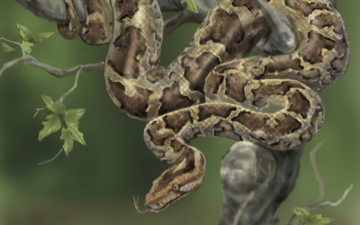Python molurus is a large, nonvenomous python species native to tropical and subtropical regions of the Indian subcontinent and Southeast Asia.[2] It is known by the common names Indian python, black-tailed python,[3] Indian rock python, and Asian rock python.[4][5] It is generally lighter colored than the Burmese python and reaches usually 3 m (9.8 ft).[6]
The rock python’s color pattern is whitish or yellowish with the blotched patterns varying from tan to dark brown shades. This varies with terrain and habitat. Specimens from the hill forests of Western Ghats and Assam are darker, while those from the Deccan Plateau and Eastern Ghats are usually lighter.[7] All pythons are non-venomous.[citation needed]
The nominate subspecies occurring in India typically grows to 3 m (9.8 ft).[6][7] This value is supported by a 1990 study in Keoladeo National Park, where 25% of the python population was 2.7–3.3 m (8.9–10.8 ft) long. Two individuals even measured nearly 3.6 m (12 ft).[8]
Because of confusion with the Burmese python, exaggerations, and stretched skins in the past, the maximum length of this subspecies is difficult to tell. The longest scientifically recorded specimen, collected in Pakistan, was 4.6 m (15 ft) long and weighed 52 kg (110 lb). In Pakistan, Indian pythons commonly reach a length of 2.4–3.0 m (7.9–9.8 ft).[9]
P. molurus occurs in India, southern Nepal, Pakistan, Sri Lanka, Bhutan, Bangladesh, and probably in the north of Myanmar.[10] It lives in a wide range of habitats, including grasslands, swamps, marshes, rocky foothills, woodlands, open forest, and river valleys. It needs a permanent source of water.[11] It hides in abandoned mammal burrows, hollow trees, dense water reeds, and mangrove thickets.[7]
(From Wikipedia, June 2021)




